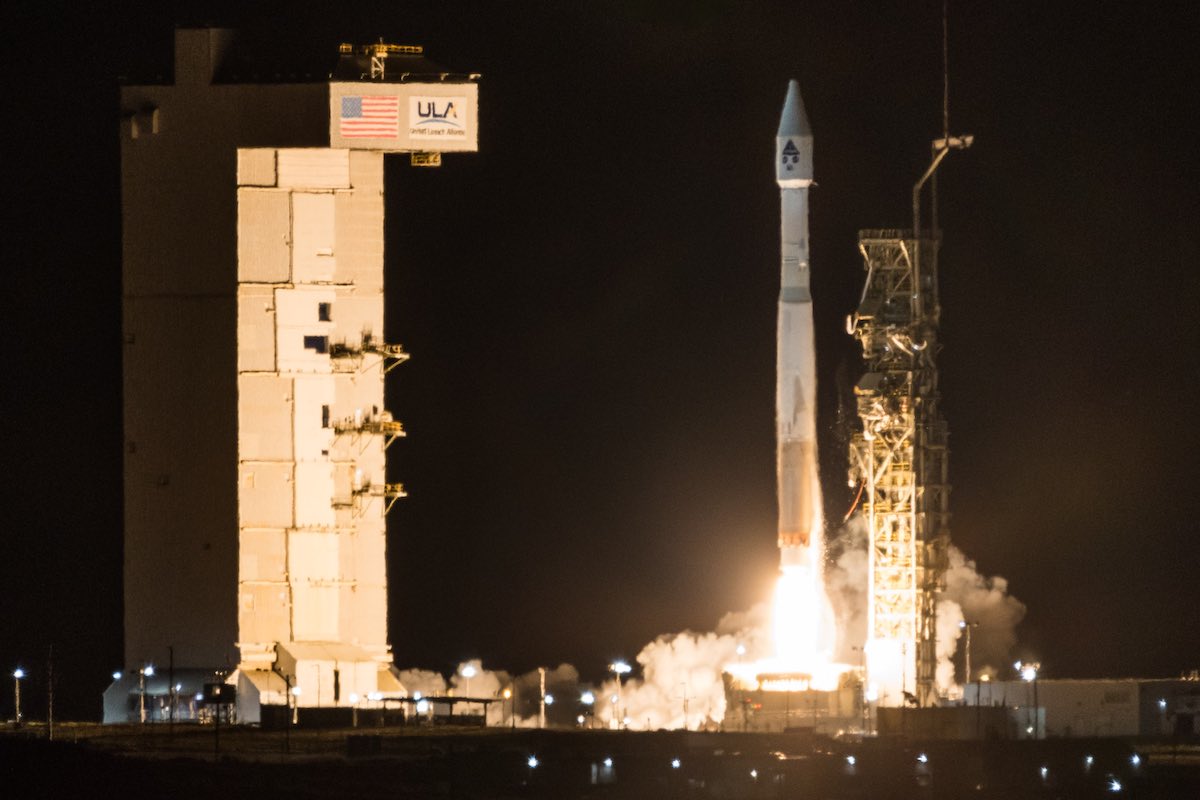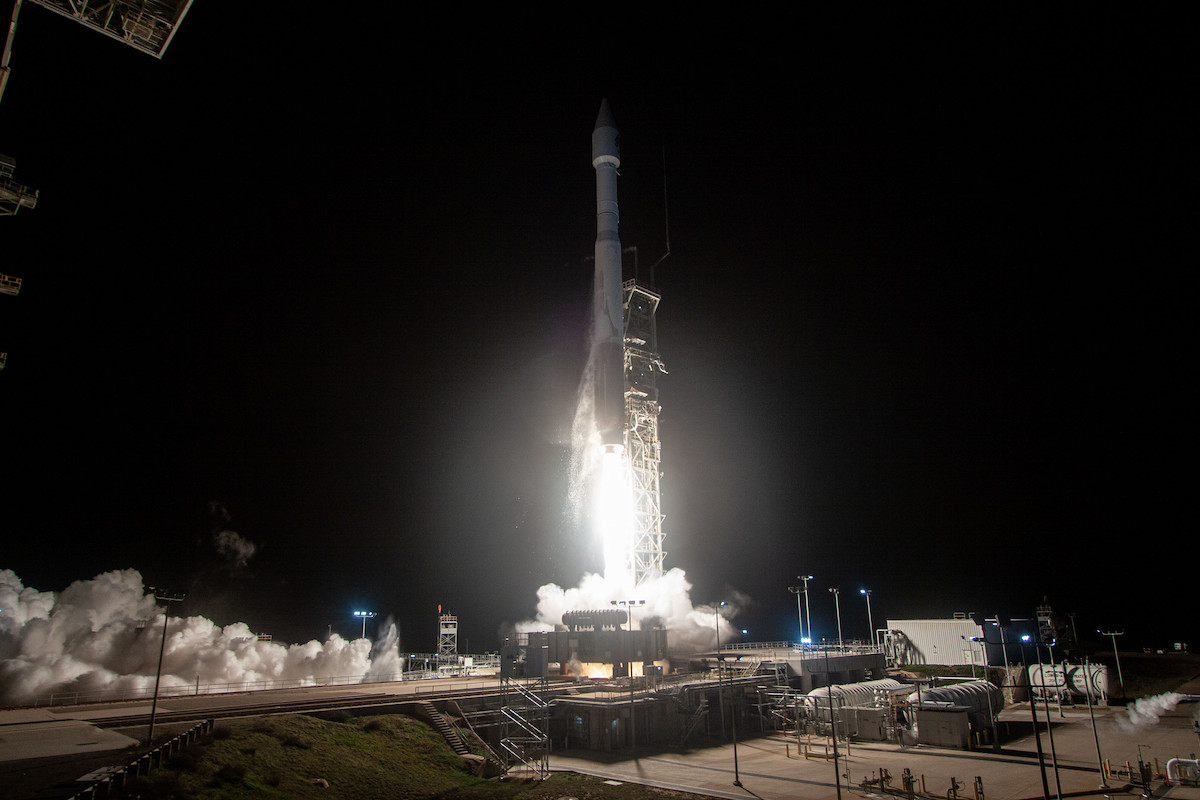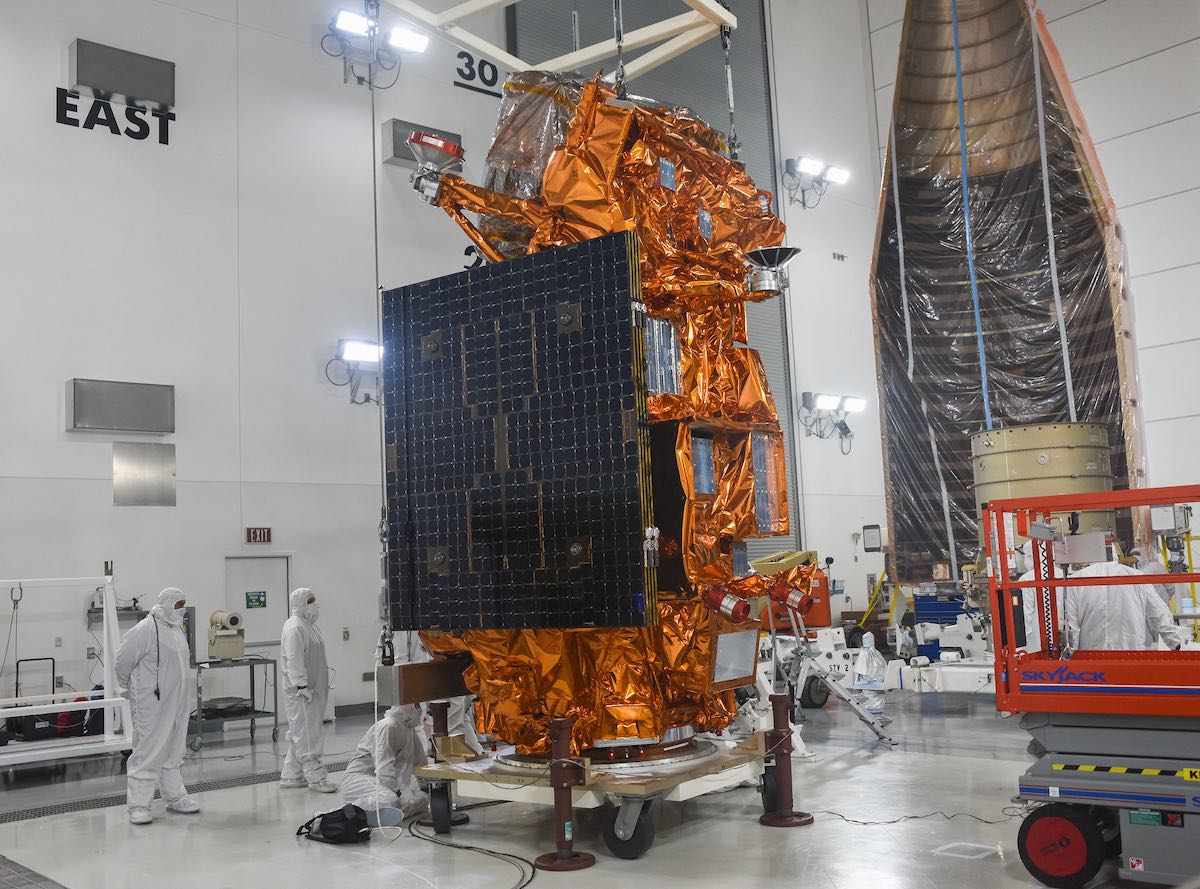Space News & Blog Articles
Atlas 5 rocket moves closer to retirement with final launch from California
 ULA’s Atlas 5 rocket lifts off from Space Launch Complex 3-East at Vandenberg Space Force Base with NOAA’s JPSS 2 weather satellite and NASA’s LOFTID re-entry tech demo experiment. Credit: Alex Polimeni / Spaceflight Now
ULA’s Atlas 5 rocket lifts off from Space Launch Complex 3-East at Vandenberg Space Force Base with NOAA’s JPSS 2 weather satellite and NASA’s LOFTID re-entry tech demo experiment. Credit: Alex Polimeni / Spaceflight Now
The 301st and final Atlas rocket to launch from California blasted off Thursday with a NOAA weather satellite and a first-of-its-kind re-entry tech demo experiment, clearing the way for modifications to ready the Atlas launch pad for United Launch Alliance’s new Vulcan rocket.
There are 19 Atlas 5s remaining in ULA’s inventory. All are slated to launch from Cape Canaveral. The predawn launch from California also marked the final Atlas 5 to fly with a classic 4-meter (13-foot) diameter payload fairing, and the last to use the most-flown variant of the Atlas 5 — the “401” configuration with a 4-meter fairing and no solid rocket boosters.
ULA’s Atlas 5 rocket lifted off from Space Launch Complex 3-East at Vandenberg Space Force Base in California at 1:49 a.m. PST (4:49 a.m. EST; 0949 GMT) Thursday carrying NOAA’s JPSS 2 polar-orbiting weather satellite. A rideshare payload called LOFTID rode into orbit below the JPSS 2 satellite inside the Atlas 5’s nose cone.
The launch team delayed liftoff 24 minutes after loading of liquid oxygen into the Atlas 5’s first stage took longer than expected due to a technical issue. Engineers declared the 191-foot-tall (58.2-meter) rocket ready for flight and resumed the countdown, culminating in ignition of the Atlas 5’s Russian-made RD-180 main engine.
The engine throttled up to full power, producing some 860,000 pounds of thrust to power the Atlas 5 off the pad at Vandenberg, a military base about 140 miles (225 kilometers) northwest of Los Angeles. The Atlas 5 headed south from Vandenberg, arcing over the Pacific Ocean as the RD-180 engine accelerated the rocket through the atmosphere for the first four minutes of the flight.
Here’s a replay of ULA’s Atlas 5 rocket climbing off its launch pad in California, carrying a new polar-orbiting weather satellite and NASA’s LOFTID experiment to test atmospheric re-entry technology. https://t.co/JoIPGW5xy6 pic.twitter.com/0h5ZUWPaai
— Spaceflight Now (@SpaceflightNow) November 10, 2022
The Centaur upper stage separated from the Atlas first stage to begin the first of three burns using its Aerojet Rocketdyne RL10 engine. The Atlas 5 shed its payload fairing four-and-a-half minutes into the mission, and the RL10 upper stage engine completed its first firing about 17 minutes after liftoff.
That set the stage for deployment of the 5,567-pound (2,525-kilogram) JPSS 2 weather satellite 28 minutes into the flight.
Built by Northrop Grumman, the JPSS 2 spacecraft is the third satellite in NOAA’s Joint Polar Satellite System series of weather observatories. It follows the launch of the Suomi NPP and JPSS 1 weather satellites in 2011 and 2017, both on ULA’s now-retired Delta 2 rocket. JPSS 2 will gather data on Earth’s atmosphere and oceans, mapping and monitoring wildfires and volcanoes, and measuring dust and smoke in the air. JPSS 2 will also track the health of the ozone layer.
JPSS 2 will fly at an altitude of 512 miles (824 kilometers), allowing its four instruments to collect data over the same location on Earth twice per day, once in sunlight and once at nighttime, as the planet rotates underneath the satellite’s orbit.
The new satellite will be renamed NOAA 21, continuing a line of U.S. government weather satellites dating back to 1960. Forecasters use data from polar-orbiting satellites to help predict weather three to seven days in advance, while NOAA’s GOES weather satellites in geostationary orbit provide real-time monitoring of severe weather and tropical cyclones.
 A Russian-made RD-180 engine powers the Atlas 5 rocket off its launch pad in California on Thursday. Credit: United Launch Alliance
A Russian-made RD-180 engine powers the Atlas 5 rocket off its launch pad in California on Thursday. Credit: United Launch Alliance
With JPSS 2 flying free of the rocket, the Atlas 5’s Centaur upper stage reignited two times to steer onto a trajectory back into Earth’s atmosphere. Then the Centaur ejected an adapter cover to reveal LOFTID, the Low-Earth Orbit Flight Test of an Inflatable Decelerator, a rideshare experiment added to the mission to take advantage of the Atlas 5’s excess payload capacity.
LOFTID is a joint effort between NASA and ULA to test an inflatable heat shield design that could be used in the future to help land massive cargo on Mars. ULA could use a similar heat shield system to help it recover rocket engines from the next-generation Vulcan rocket for refurbishment and reuse.
High-pressure tanks of nitrogen gas carried inside the LOFTID re-entry vehicle opened to inflate the heat shield, which was folded and packed to fit inside a volume about 4.3 feet (1.3 meters) wide and 50 centimeters (1.6 feet) tall. Once fully pressurized to 19 psi, the heat shield expanded to a diameter of nearly 20 feet (6 meters).
The inflatable heat shield is much lighter than a rigid heat shield, such as thermal protection systems used on crew capsules, and take up less volume inside a rocket’s payload fairing. The technology will allow future NASA missions to deliver more massive rovers, landers, and eventually human-rated habitats to the Martian surface — payloads weighing tens of tons.
The heaviest spacecraft ever landed on Mars using current technology was the Perseverance rover, which weighed about a ton when it arrived at the Red Planet in 2021.
The LOFTID tech demo is part of NASA’s Hypersonic Inflatable Aerodynamic Decelerator, or HIAD, program. NASA has flown suborbital tests of smaller inflatable heat shields, but the LOFTID mission was the largest such decelerator ever tested, and the first to re-enter the atmosphere from orbital velocity.
 NOAA’s JPSS 2 weather satellite in a payload processing facility at Vandenberg Space Force Base before encapsulation inside the Atlas 5 rocket’s payload fairing. Credit: USSF 30th Space Wing/Carlos Velasco
NOAA’s JPSS 2 weather satellite in a payload processing facility at Vandenberg Space Force Base before encapsulation inside the Atlas 5 rocket’s payload fairing. Credit: USSF 30th Space Wing/Carlos Velasco
Once the LOFTID heat shield was inflated, the Atlas 5’s Centaur upper stage fired thrusters to spin up and release the roughly 2,700-pound (1,224-kilogram) spin-stabilized re-entry vehicle. The rocket’s upper stage fell back into the atmosphere, with most of it burning up over the Pacific Ocean.
LOFTID re-entered the atmosphere, withstanding 9 Gs and temperatures near 2,600 degrees Fahrenheit (1,400 degrees Celsius) before deploying a parachute to slow its descent for splashdown. A recovery ship chartered by ULA retrieved the spacecraft from the Pacific Ocean east of Hawaii.
The launch from California Thursday marked the end of an era for ULA, with modifications to the SLC-3E launch pad set to begin in the coming weeks to ready the West Coast facility for the Vulcan rocket.
ULA has completed modifications to launch facilities at Cape Canaveral for the Vulcan Centaur rocket. Vulcan flights will take off from Space Launch Complex 41 at the Cape, the same site used by Atlas 5 rockets. Atlas 5 and Vulcan rockets will share the same pad, with different mobile launch platforms, over the next several years.
The cutover to the Vulcan program won’t be backward compatible at Vandenberg, meaning ULA won’t preserve the capability to launch Atlas 5s from the West Coat.
“After launch, the team is going to start de-integrating and safing all the hazardous systems so that we can come in and make significant modifications to the platforms, to the facility,” said Gary Wentz, ULA’s vice president of government and commercial programs.
 Artist’s illustration of a Vulcan Centaur launch. Credit: United Launch Alliance
Artist’s illustration of a Vulcan Centaur launch. Credit: United Launch Alliance
The Atlas 5’s first stage burns kerosene fuel mixed with liquid oxygen, while the new Blue Origin-built BE-4 engines powering the Vulcan’s first stage will burn methane and liquid oxygen. That requires the installation of new methane storage tanks and propellant lines to load the fuel into the Vulcan rocket at SLC-3E.
“The Vulcan Centaur is using different commodities so we have to run those feed lines in and mate those up to the launch platform. So we’re going to start a significant de-integration and then manufacture a capability to be able to launch Vulcan Centaur with an initial capability early in the spring of ’24.”
The Atlas 5 launch pad at Vandenberg has a mobile gantry that allows ground crews to stack rocket segments on the launch pad. The service tower wheels away in the final hours before liftoff, revealing the rocket before cryogenic propellants are pumped aboard. At Cape Canaveral, ULA stacks the Atlas 5 rocket inside a fixed Vertical Integration Facility. The rocket then rides a mobile transporter to the launch pad.
The mobile gantry at SLC-3E will be modified to accommodate the wider diameter of the Vulcan rocket. But ULA won’t need to raise the structure’s height, which was increased in the 2000s to update the pad for Atlas 5 missions.
ULA’s first Vulcan test flight is slated for launch from Cape Canaveral in 2023 on a mission to loft a pair of test satellites for Amazon’s Kuiper broadband network, along with a commercial moon lander for Astrobotic. That will be followed later next year by the second Vulcan test flight, with Sierra Space’s first Dream Chaser spaceplane on a resupply mission to the International Space Station.
Here’s a replay of the LOFTID re-entry vehicle inflating with nitrogen gas before separating from the Atlas 5’s Centaur upper stage.
LOFTID is testing tech that could be used to land heavy cargo on Mars, or recover reusable rocket engines.https://t.co/JoIPGW4ZIy pic.twitter.com/Fot7Cxnasr
— Spaceflight Now (@SpaceflightNow) November 10, 2022
Future Vulcan launches will haul payloads to space for the U.S. military, which in 2020 selected ULA’s Vulcan and SpaceX’s Falcon 9 and Falcon Heavy rockets to carry national security satellites into orbit on missions through 2027. So far, ULA has not won any Vulcan launch contracts for flights out of Vandenberg, but has reservations for more than 50 Vulcan flights from Cape Canaveral.
But the Pentagon requires ULA and SpaceX main the ability to launch missions from the East Coast and the West Coast. Launches out of Vandenberg typically target polar orbits, a destination for the government’s spy satellites, weather monitoring spacecraft, and future early warning and missile detection platforms.
The first Atlas launch from Vandenberg occurred in 1959 with a suborbital test of an Atlas intercontinental ballistic missile. Atlas rockets began launching in 1960 from SLC-3, which included a West pad and an East pad. The first Atlas launch from SLC-3E occurred July 12, 1961.
The SLC-3E launch pad was decommissioned after an Atlas launch in 1987, then brought back online for three flights of the Atlas 2AS rocket from 1999 through 2003. Ground crews then converted the pad for the Atlas 5 rocket, which stands taller than older Atlas rocket configurations, and uses the Russian RD-180 main engine.
ULA launched 17 Atlas 5 rockets from SLC-3E, including a mission in 2018 with NASA’s InSight Mars lander, the first probe to the Red Planet to lift off from Vandenberg.
This email address is being protected from spambots. You need JavaScript enabled to view it. the author.
Follow Stephen Clark on Twitter: @StephenClark1.
When you subscribe to the SpaceZE News Feed, we will send you an e-mail when there are new updates on the site so you wouldn't miss them.

